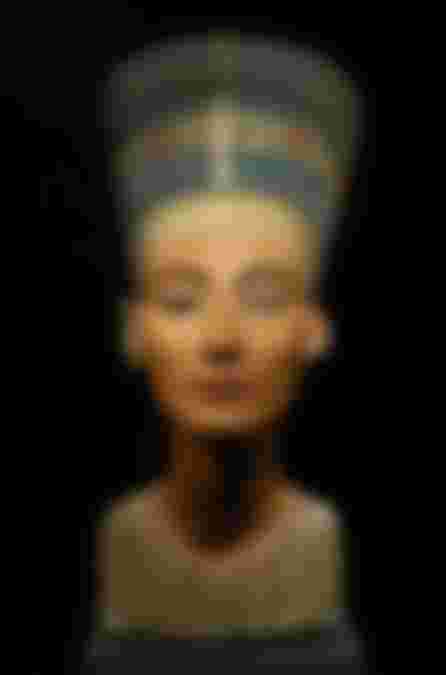One of the most mysterious and powerful women in ancient Egypt.

Nefertiti, one of the most mysterious and powerful women in ancient Egypt, was the wife of Pharaoh Amenhotep, later Akhenaten, from 1353 to 1336 BC, who ruled even after the death of her husband. The time of her reign was a time of great religious reform, because Akhenaten reoriented the religious and political structure of Egypt around the worship of the god Aten.
Nefertiti is best known for its sand bust, which was found in 1912 and very quickly became a symbol of beauty and power. Speaking of beauty, we must also mention the meaning of her name: Nefertiti - "beauty has arrived".
QUEEN NEFERTITI
Not much is known about her origins. There are various theories, but the most common is that Nefertiti is the daughter of the Egyptian dignitary Aya, who became a pharaoh after Tutankhamun's death in 1323 BC. According to another theory, she is the princess of the kingdom of Mitanni from northern Syria. Later, when Amenhotep IV came to the throne, his favorite wife was with him. In the fifth year of his reign, he changed the worship of the Egyptian supreme god Amon in favor of Aten and moved the capital to the north of Amarna. He closed the temples of Amon, and changed his name to Akhenaten, which means "servant of Aten." Also, Nefertiti added Neferneferuaten - her full name means "The beauties of Mount Athos are beautiful, the beauty has arrived".
Akhenaten's transformation of religion brought radical changes in art as well. Starting from earlier idealized images of pharaohs, Akhenaten is sometimes depicted with female hips and hyperbolically. Earlier, Nefertiti's paintings portrayed her as a stereotypical representation of a woman, but later she was portrayed similarly to Akhenaten's paintings. Her final descriptions depict a royal but realistic figure.
On the walls of tombs and temples built during the reign of Akhenaten, Queen Nefertiti is always depicted next to her husband, which was not the case with any other Egyptian queen. In many cases, she was portrayed in a position of power and authority, leading the worship of the god Aten.
Since Nefertiti could not give a male heir (they had six daughters), her husband began to enter into relationships with other women, including his own sister. Some experts believe that she was the woman with whom he got the future pharaoh Tutankhamun.

NEFERTITI AS A POSSIBLE RULER
Nefertiti officially disappears from historical records around the 12th year of Akhenaten's 17-year reign. There are two theories: that Nefertiti died in that period and that she became the official co-ruler of her husband, but under the name Neferneferuaten. Akhenton's successor was Pharaoh Smenkhara, who some historians claim is Nefertiti's second name. That would not be unprecedented. It is known that in the 15th century BC, the female pharaoh Hatshepsut ruled Egypt, dressed as a man, wearing a false beard.
If it is true that Nefertiti retained power during and after the reign of Akhenton in recent years, it is very possible that she began to annul the religious policy of her husband, which reached its peak during the reign of Pharaoh Tutankhamun. At one point, Neferneferuaten hired a scribe to offer a great divine gift to Amun and to beg him to return and remove the darkness from the kingdom.
BISTA NEFERTITI
A bust of Queen Nefertiti was found on December 6, 1912, during excavations led by Ludwig Borchardt in Amarna, in the then discovered studio of the Egyptian chief sculptor Thutmose. The painted figure is presented with a long slender neck, a graceful proportionate face and an authentic blue cylindrical head ornament. Borchardt's team had an agreement with the Egyptian government to separate this item from the rest and to have the bust delivered as part of a German shipment. The news of this invention was published in a newspaper with a small photo and then given to the financier of this expedition, James Simon, who kept it on display for the next 11 years in his private residence.
In 1922, British Egyptologist Howard Carter discovered Tutankhamun's tomb. The attention of the world media was focused on this invention, which was accompanied by a picture of Tutankhamun's mask made of pure gold, as a symbol of beauty, wealth and power.
A year later, a bust of Nefertiti was exhibited in a museum in Berlin, in response to the English finding them. During the riots in the 20th century, the bust remained in German hands. Hidden from the Allied bombs in the salt mine, and revered by East Germany during the Cold War, the bust that Adolf Hitler admired today attracts more than half a million visitors a year to the Egyptian Museum in Berlin.


Wow she has so many history and i was quite amazed to read about her and I absolutely loved it